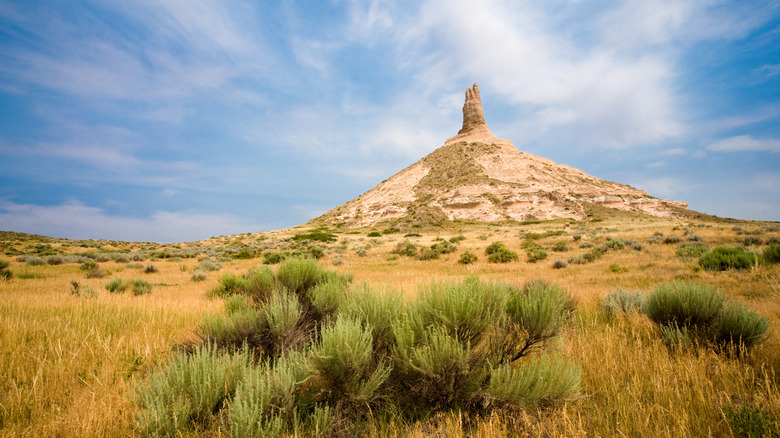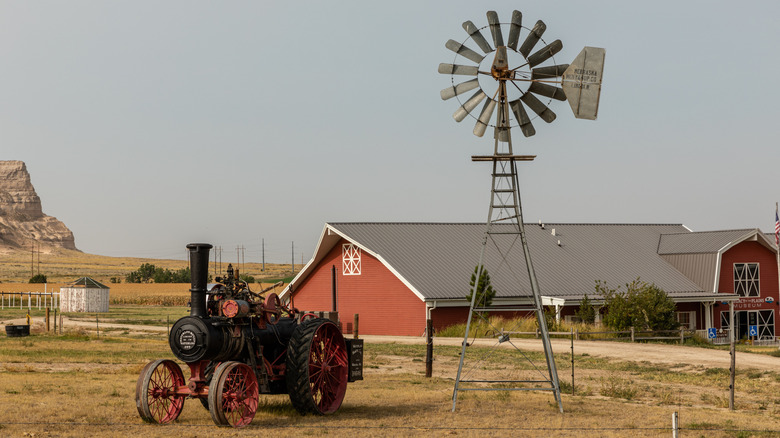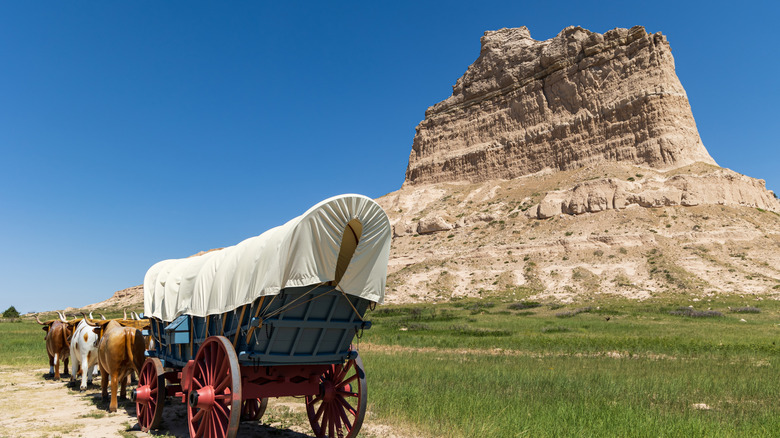This Hidden Nebraska City Is A Gateway To America's Legendary Trails And Pioneer History
Hidden in the middle of Nebraska's panhandle is a small, quiet city that's a gateway to one of the most recognizable landmarks in pioneer history. Bayard might only have a population of 1,500, but in the mid-19th century, about 350,000 people crossed through this area in search of a new life out west.
Just outside of Bayard stands Chimney Rock, a unique rock formation that was used as a marker and navigation point for hundreds of thousands heading west on the legendary Oregon, Mormon, and California trails, all of which passed by the north side of this 300-foot landmark whose thin spire could be seen from miles away. Chimney Rock was one of the most recognizable monuments on the Oregon Trail, mentioned in more pioneer diaries than any other location. It's definitely recognizable to folks of a certain age, who mostly learned about the Oregon Trail from the classic video game and might remember the sweet relief of hearing "Auld Lang Syne" play at Chimney Rock after fording a river or two without dying from dysentery or snake bites.
Bayard is a 30-minute drive from Scottsbluff, the largest city in the Nebraska panhandle, as well as from the Scotts Bluff National Monument, a must-visit location for anyone interested in American history. Its location makes it perfect for a road trip exploring Nebraska's wild west and pioneer history – it's just an hour north of the I-80, which follows part of the Oregon Trail — although bigger cities like Fort Collins, Colorado, are just 2.5 hours away. The closest major international airport is in Denver, just over three hours away.
The pioneer history of Bayard
Not surprisingly, Bayard's history goes back to the days of the pioneers. The town was established in 1888, over 50 years after the first families set out on the Oregon Trail in 1836. After the Louisiana Purchase in 1803 nearly doubled the size of the United States, there was a frenzied expansion out west, particularly once gold was discovered in California in 1848. A number of cross-country trails intersected at Chimney Rock, whose towering spire in the midst of Nebraska's flat plains offered a taste of what was to come for these settlers who had never seen the landscape of the west before (spoiler alert: big rocks and bigger mountains).
The Oregon Trail crossed more than 2,000 miles from Missouri to Oregon, while the California Trail led over 250,000 settlers to the west coast in search of gold, and the Mormon Trail was blazed in 1846 by followers of a new religion seeking refuge in the Salt Lake Valley after mounting tensions forced them to leave their base in Illinois.
You can follow in the footsteps of these pioneers along four short, well-maintained paths leading you within 300 yards of the 325-foot tall monument that was once known as "Elk Penis" by indigenous tribes and later "Elk Peak."
Visitors to Chimney Rock begin their journey at the Chimney Rock Museum located at the Ethel S. and Christopher J. Abbott Visitor Center. The museum and site are open year-round, but days depend on the season. From May 1 to September 30, they're open every day from 9 a.m. to 4 p.m, and from October 1 to April 30, they're open the same hours from Tuesday to Saturday.
What to do in and around Bayard
In 1849, one settler wrote about Chimney Rock that "No conception can be formed of the magnitude of this grand work of nature until you stand at its base & look up. If a man does not feel like an insect then I don't know when he should," according to the National Park Service. For those who want to experience this for themselves, you can camp with your RV under the shadow of the rock and the open sky, just like the pioneers who used a different type of covered wagon, by booking a spot at the Chimney Rock Pioneer Crossing RV Park.
For more pioneer history, head to Scotts Bluff National Monument, a massive 800-foot rock formation above the North Platte River. Like Chimney Rock, it served as a landmark for settlers heading out west and a vision of the dramatic landscape and dangerous crossings that awaited them across the Rockies. Luckily, you can get to the top easier by car than those oxen-drawn buggies did to enjoy the sweeping vistas. Hikers can explore parts of this area's 3,000 acres of land across four miles of trails.
For insight into non-pioneer, 20th-century history, head to the Bayard Depot Museum, located in a train depot built in 1928. This charming brick building houses a small museum that's free and offers information about the area's railroad history.


